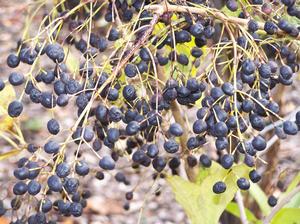
Chionanthus virginicus is but one of many plants whose annual timing is followed at Arnold Arboretum. A dioecious woody, the remarkable autumn fruit is olive-like on the females.
The Science of Phenology
Phenology is the study of seasonal change and timing of organisms. According to the University of Maine, "This growing field of science examines cyclical events in animal behavior and plant growth. A plethora of organisms, including humans, depend on the predictable nature of seasonal turns. Animal migrations, insect metamorphosis and plant growth cycles all rely on specific movements of nature."
Farmers, gardeners, fisherman and naturalists, the latter exemplified by Henry David Thoreau and Ralph Waldo Emerson, through the centuries have noted the timing of garden, field, woodland and barnyard events. Today as with the threads of Phenology's humble origins refined training is not required to carefully observe and take notes.
Eventually the grassroot threads bound together into the observational science of Phenology with the emphasis on logging annual times and trends of living creatures as well as shifts in circadian rhythms. The science looks at the timing of leaf break in spring as well as leaf fall in autumn. Migrations of birds, the emergence of hibernating animals from their winter dens, insect larva hatching from eggs and Monarch Butterfly migration are examples of but a few of the vast number of creatures being studied. The work of some scientists and interested environmentalists is following the trends of plants and animals actually migrating north over time and even up the slopes of mountains seeking the cooler conditions necessary for their survival. Phenology has expanded to include timing of glacier movement and melt, snowpack, dissipation and more subtle aspects of hydrology and their impacts upon living organisms which depend upon these sources of water.
Phenology's increasing prominence is due to climate change which is quickly altering and in too many cases deeply stressing the relationship between circadian rhythms and living creatures of all ilk. Many species are moving closer to being out of sync with seasonal timing shifts. And because of off-timing some species have already gone extinct. Climate change is evidenced in many aspects of phenology. For instance, Chionanthus virginicus, the shrub or small tree known as Old Man's Beard or Fringetree was flowering fully 7 weeks earlier at Arnold Arboretum in 2003 as compared with 1926. Chionanthus virginicus as with many species has demonastrated an increasing surge in earlier and earlier flowering times; this more dramatically noted over the past 30 years as the Earth has warmed quicker in these decades. It must be said that Chioanthus virginicus is a bit of an outlier. Charts show that between 1882 and 2002 the timing of the 229 species followed for this 120-year period the differential averaged 10 days, some flowering much earlier, some less. However, the trend line is clear.
Phenology is a useful reference to scientists, naturalists, climatologists and ecologists in understanding the trend line of a species in relation to temperature changes through many years. It is also important as a prediction tool in knowing which species and when may be in particular danger. Following a given species through the years aids in projecting an educated guess as to its breaking point. In that, certain species may be saved with intervention. Furthermore, if one understands the interrelations of that species on the brink and its importance to others in the web of life within its ecosystem this information can aid not only in intelligent projections but perhaps in some cases stop-gap remedies that may affect the viability of all.
Remember, none of life occurs in a vacuum divorced from all else and others. Building blocks are shifting and some are falling to the wayside. The good news is that everyone can partake in the science of Phenology. It may be a great student assignment, one that can be passed on to the next class. Perhaps an ongoing project whose adoption might be considered by youth leagues, scouting organizations and adults alike could become a tradition, - the newbies adding to the previously collected data of former members. One does not have to hold a degree to take notes. For instance, amateur birders perform annual counts noting the dates of arrivals, departures and numbers of various species. With a calendar, notebook, writing utensil, subject choice and a bit of observation it is easy to take notice and mark annual dates. And with weatherproof wildlife camera technology often used by hunters observations can be as effective and more easily performed than by persistent and very time consuming manual observation although the quiet, gentle serenity of this task is efficacious, not unlike therapy! Pick a subject. The data you collect will be gladly considered by foundations, scientists and universities. And computer technology makes the sharing and transference quick as can be. It is very important that we all become more aware of our changing environment and the implications of careens and shifts. And this could be a fun way to focus student attention upon an issue that is fundamental to the well-being of all.
penned by Wayne Paquette in November, 2015 for The Potting Shed, Villager Newspapers